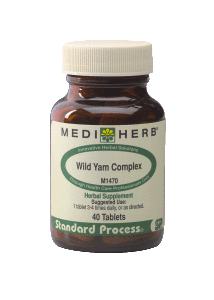- provide relief from discomfort associated with menopause
- promote a natural, healthy balance within the mature female endocrine system
- maintain feelings of general well-being
- balance and support normal female physiology and function
- calm the nerves and restore balance in temporary mood swings
- provide antispasmodic activity to ease occasional spasms of smooth muscle including those associated with the menstrual cycle Δ
| Content | Product # |
|---|---|
| 40 Tablets | M1470 |
| 120 Tablets | M1475 |
Suggested Use: 1 tablet 3 – 4 times daily, or as directed.
SERVING SIZE: 1 TABLET
SUPPLEMENT FACTS
| Amount Per Serving | %DV | |
|---|---|---|
| † Daily Value (DV) not established. | ||
| Calories | 2 | |
| Calcium | 19 mg | 2% |
| Wild Yam root & rhizome 4:1 extract from Dioscorea villosa root & rhizome 400 mg | 100mg | † |
| Shatavari root 4:1 extract fromAsparagus racemosus root 400 mg | 100mg | † |
| St John’s Wort herb flowering top 6:1 extract from Hypericum perforatumherb flowering top 600 mg Containing hypericins 300 mcg |
100 mg | † |
| Sage herb 5:1 extract from Salvia fruticosa herb 290 mg | 58 mg | † |
| Black Cohosh root 5:1 extract fromCimicifuga racemosa root 100 mg | 20 mg | † |
| Korean Ginseng root 5:1 extract fromPanax ginseng root 75 mg Containing ginsenosides 1.3 mg Rb2 to Rb1 is NLT 0.4 by HPLC |
15 mg | † |
Other Ingredients
Cellulose, calcium acid phosphate, sodium starch glycollate, silica, hypromellose, magnesium stearate and glucose.
Caution: Contraindicated in pregnancy . Contraindicated during lactation unless otherwise directed by a qualified health care professional. Discontinue during an acute infection or fever. Caution in patients with liver problems, who frequently use alcohol or take any medications. Do not use this product while taking any prescription drug(s) without the advice of your prescribing physician. Avoid excessive exposure to UV irradiation (e.g., sunlight, tanning) when using this product.
For other contraindications and cautions specific to this product, please refer to the Contraindications and Cautions for MediHerb Botanicals.
Wild Yam Quality
There are some 600 species of Yam in the genus Dioscorea, many of them are wild species that flourish in damp woodlands and thickets. Dioscorea villosa, also known as Colic Root or Wild Yam, is a twining, tuberous vine native to eastern North America. The roots initially taste starchy, but soon after are bitter and acrid, nothing like the taste of Yam or Sweet Potato grown for the dinner table. Commercial Wild Yam extracts available for use as raw materials are often notDioscorea villosa but instead Dioscorea opposita (Chinese Yam Root) which has a different phytochemical profile.
Please consult the product packaging label for the most accurate product information.
Δ These statements have not been evaluated by the Food & Drug Administration. These products are not intended to diagnose, treat, cure or prevent any disease.

